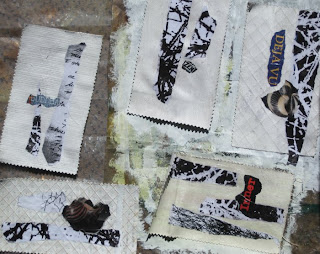Every year Karen Stiehl Osborn organizes a collage exchange among fiber artists. Her website-
here.
We make 11 collages and send them to her. She shuffles them and sends 11 back. It’s great fun to see the collages you get in return.
This collage series is called Fiberworks.
I had a bunch of fabric samples from an upholstery book. I used these as the base of my collages. I started by applying lightweight molding paste to them.
This will provide tooth and a white base. The white base is similar to gesso and will let the colors come though brighter. The molding paste is thicker than gesso and can leave lovely texture marks. This helps to cover some of the texture in the fabric too.
After this dried, I tore magazine clippings and some of my black and white inkjet images that I use to create thermo fax screens. This turns out to be a great way to recycle these and add to my collage stash.
I applied this using gel medium. After it dried I went in and painted with acrylic color. This was dried and I stitched black thread drawing marks.
Mounted with mats and send off.
I can’t wait to see the collages that come back!











